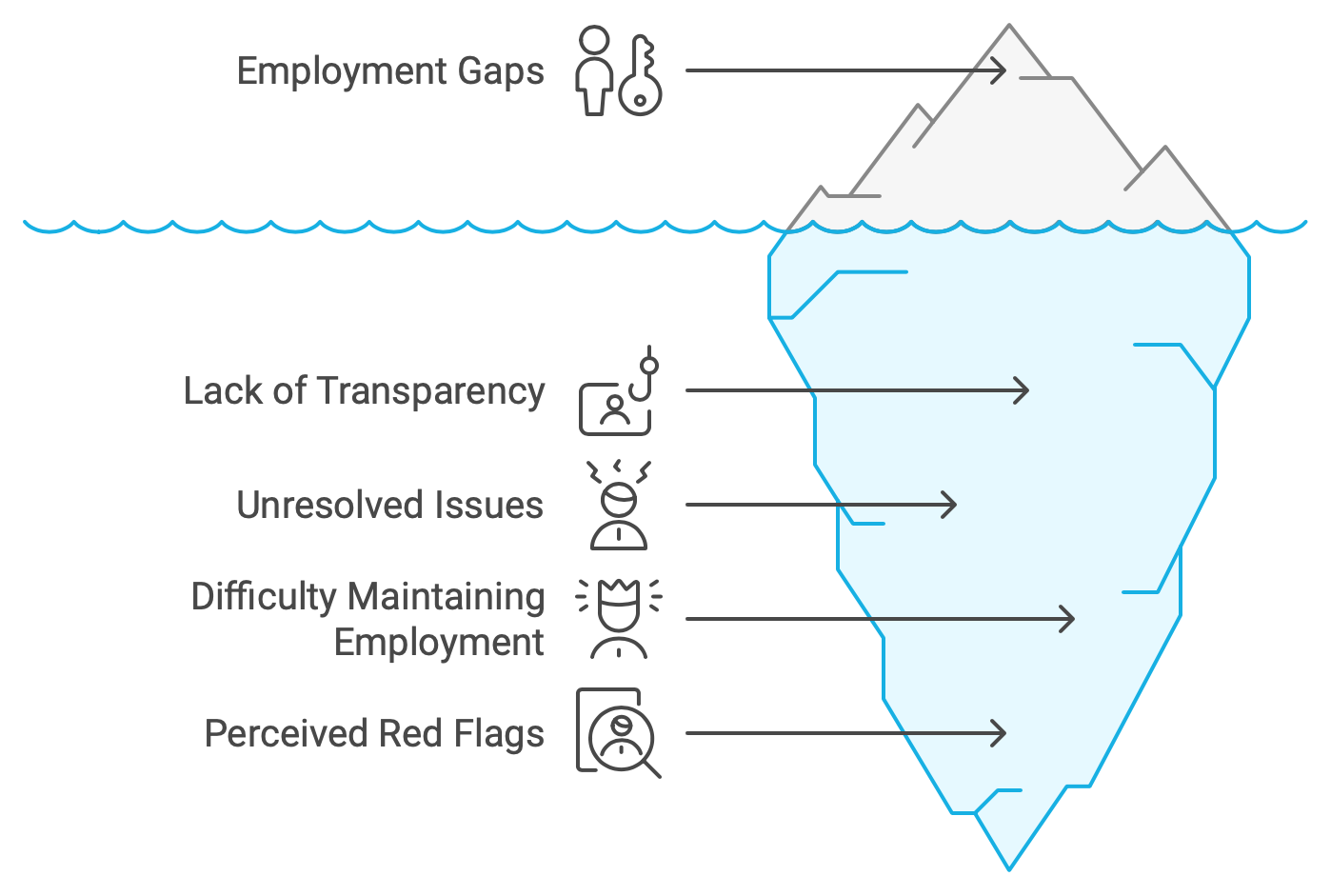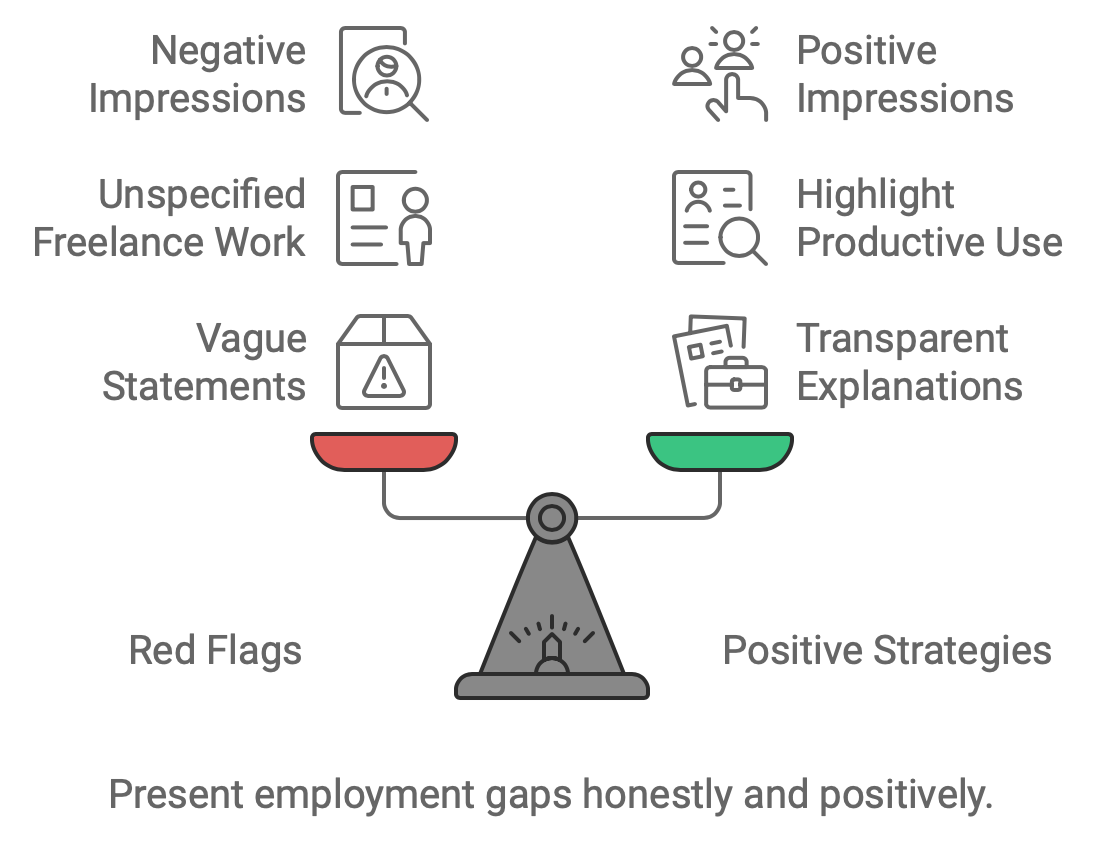Recruiters often look beyond qualifications when assessing resumes
They’re also searching for red flags that may indicate potential issues. One of the most common concerns is how candidates handle employment gaps. While gaps are not unusual, how you present them can make a significant difference in a recruiter’s perception of your professionalism and commitment. In this article, I’ll share insights from my experience as a recruiter to help you navigate these tricky areas.
How to Address Employment Gaps: Be Transparent, Not Vague
Employment gaps are common and can occur for various reasons—family, education, health, or personal growth. However, what raises red flags is when these gaps are poorly explained or seem to be intentionally obscured. Candidates who stretch dates or provide unclear justifications can create doubt in a recruiter’s mind. Our talent acquisition experts guide candidates on how to present these gaps effectively, turning potential weaknesses into strengths.

Examples of Red Flags
- Vague Statements: Listing a gap with explanations like “personal reasons” or “took time off” without any further detail can be concerning. While recruiters don't need to know every aspect of your personal life, vague responses can suggest you might be hiding something, such as difficulties maintaining employment or unresolved issues at previous jobs.
- Unspecified “Freelance” Work: Another common tactic is to list freelance or self-employment work during gaps. However, if this is not supported with clear descriptions of projects, clients, or outcomes, it can look like filler. Recruiters expect specific details, not placeholders to mask employment gaps.
- Unspecified “Freelance” Work: Another common tactic is to list freelance or self-employment work during gaps. However, if this is not supported with clear descriptions of projects, clients, or outcomes, it can look like filler. Recruiters expect specific details, not placeholders to mask employment gaps.

What to Do: Present Gaps Honestly and Highlight Productivity
Employment gaps aren’t necessarily a dealbreaker, but how you address them can greatly impact how recruiters perceive you. Here’s how to present them in a way that demonstrates honesty and highlights your growth:
1. Be Transparent but Brief:
- Instead of trying to hide gaps, briefly explain them. For example: “Took a year off to care for a family member” or “Career break for personal development.” Keep it short and to the point so it doesn’t overshadow your experience.
2. Highlight Productive Use of the Gap:
- If you used the time off for courses, volunteering, or freelancing, highlight this. For instance: “Career break (2019-2020): Completed certification in digital marketing and volunteered as a project coordinator for a local non-profit.” This shows that you remained engaged and proactive, even during your time away from formal employment.
3. Frame the Gap as Part of Your Growth Story:
- Use your career break to showcase how it contributed to your skills, resilience, or decision-making. Mention this in your resume summary or during interviews: “During my break, I gained a new perspective on my career path and deepened my understanding of [specific area]. I’m now even more focused and driven to contribute in [your target role].”
1. Be Transparent but Brief:
- Instead of trying to hide gaps, briefly explain them. For example: “Took a year off to care for a family member” or “Career break for personal development.” Keep it short and to the point so it doesn’t overshadow your experience.
2. Highlight Productive Use of the Gap:
- If you used the time off for courses, volunteering, or freelancing, highlight this. For instance: “Career break (2019-2020): Completed certification in digital marketing and volunteered as a project coordinator for a local non-profit.” This shows that you remained engaged and proactive, even during your time away from formal employment.
3. Frame the Gap as Part of Your Growth Story:
- Use your career break to showcase how it contributed to your skills, resilience, or decision-making. Mention this in your resume summary or during interviews: “During my break, I gained a new perspective on my career path and deepened my understanding of [specific area]. I’m now even more focused and driven to contribute in [your target role].”
Conclusion: Turn Employment Gaps into Strengths
Employment gaps don’t have to be a stumbling block in your job search. By addressing them honestly, highlighting your productive use of time, and framing them as part of your growth story, you can transform potential concerns into a compelling narrative. Keep your resume clear, focused, and aligned with the job you’re pursuing, and you’ll be better positioned to make a positive impression on recruiters.
Need help refining your resume? Reach out for personalized advice, or download our free guide on crafting a standout resume that impresses recruiters!
Continue reading - Resume Red Flags - Part 1 and Part 3
Do you need your CV and LinkedIn profile revision? Or do you need to attract the right people and foster a strategy that would suit your specific team? Do not be afraid to ask any questions and book a call!
My Telegram
My LinkedIn
Need help refining your resume? Reach out for personalized advice, or download our free guide on crafting a standout resume that impresses recruiters!
Continue reading - Resume Red Flags - Part 1 and Part 3
Do you need your CV and LinkedIn profile revision? Or do you need to attract the right people and foster a strategy that would suit your specific team? Do not be afraid to ask any questions and book a call!
My Telegram
My LinkedIn
